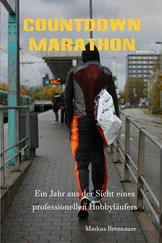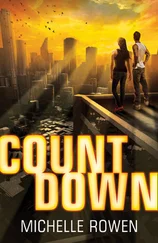Ruth Wind - Countdown
Здесь есть возможность читать онлайн «Ruth Wind - Countdown» — ознакомительный отрывок электронной книги совершенно бесплатно, а после прочтения отрывка купить полную версию. В некоторых случаях можно слушать аудио, скачать через торрент в формате fb2 и присутствует краткое содержание. Жанр: unrecognised, на английском языке. Описание произведения, (предисловие) а так же отзывы посетителей доступны на портале библиотеки ЛибКат.
- Название:Countdown
- Автор:
- Жанр:
- Год:неизвестен
- ISBN:нет данных
- Рейтинг книги:3 / 5. Голосов: 1
-
Избранное:Добавить в избранное
- Отзывы:
-
Ваша оценка:
- 60
- 1
- 2
- 3
- 4
- 5
Countdown: краткое содержание, описание и аннотация
Предлагаем к чтению аннотацию, описание, краткое содержание или предисловие (зависит от того, что написал сам автор книги «Countdown»). Если вы не нашли необходимую информацию о книге — напишите в комментариях, мы постараемся отыскать её.
Countdown — читать онлайн ознакомительный отрывок
Ниже представлен текст книги, разбитый по страницам. Система сохранения места последней прочитанной страницы, позволяет с удобством читать онлайн бесплатно книгу «Countdown», без необходимости каждый раз заново искать на чём Вы остановились. Поставьте закладку, и сможете в любой момент перейти на страницу, на которой закончили чтение.
Интервал:
Закладка:
Something nagged her tonight, a sense of something glimpsed out of the corner of her eye, something visible only in peripheral vision. She wanted another look at the code, to see if that jarred anything loose.
Her study was a plain room with open desks and two computers. The blinds were drawn. It was quiet so late. Her neighbors were largely young professionals like herself, with jobs in the local “alphabet agencies”—CIA, NSA, FBI—or the military installations in and around Washington, D.C., and Baltimore.
While she waited for the computers to boot, Kim ate her sandwich and admired the view of her kitchen from the office chair. A large jade plant stood on the windowsill, and on the wall behind the table was an enormous red-and-black Navajo blanket. It had been a gift from her mentor and reminded her of the time she’d spent at the Athena Academy for the Advancement of Women in Arizona. Athena educated girls ages ten to eighteen, at a state-of-the-art facility where girls trained in academics, martial arts, languages and other leadership skills.
Kim was proud of her little condo. Few women in her traditional Italian family lived on their own, even when they were twenty-five, as Kim was. Even fewer lived outside the enclave in Baltimore known as Little Italy. Not one of them had purchased real estate, not on her own.
It was one of the first goals Kim had made and met. The modern, two-bedroom condo was not particularly notable, though she loved the big windows and the master bedroom loft, but it was all hers. All modern convenience and post-turn-of-the-century architecture, which she’d decorated in a bright, coral-and-turquoise Southwestern theme. Some locals thought it was kitschy—so “last year,” as one friend had said—but for Kim, it was a reminder of the things she’d learned in the harsh and beautiful world of the desert. So much of who she was came from those days outside of Phoenix.
As she waited for her computer to load various programs and go through the virus checks, she switched on the radio that sat on the corner of her desk. The dial was tuned to a world music station that played a variety of Latin, African and European selections. The switches helped keep her awake.
Usually.
When the computers were up and running, she clicked on the icons to download e-mail on both machines.
Kim had three e-mail addresses—one for personal mail on her home computer, one for NSA-related material, which had a dedicated line the government paid for.
A third address was used strictly to receive e-mail from a top-secret, outside agency, called Oracle. It was located on her personal machine, to avoid any cross-contamination from work.
On the work computer, she dialed into the government network, where she would be able to explore the files connected to the current case. It was sometimes laborious signing in, but tonight the computer whizzed through the screens, the layers and layers of security designed to thwart hackers.
Most of them, anyway. No system was entirely safe, no matter what the government wanted to believe. They did their best. It was a fairly tight system, and whenever a weakness was discovered, computer security experts were on the spot to fix it.
On her home computer, the personal e-mails sorted into one folder. Twenty-seven, which was a lot for her in one day. She frowned. She’d check them in a minute, but first she switched IDs and asked the computer to fetch her Oracle e-mails. Maybe they’d have something to help crack this code.
Oracle was a special computer system developed to track information gathered from FBI, CIA, NSA and military databases, to be then cross-checked and matched. Created in the days before Homeland Security, it had been developed to help avoid disasters like Pearl Harbor and the 1993 Trade Center bombing, events that might have been prevented had key information been shared between agencies.
Kim had been recruited through AA.gov, a Web site connecting Athena Academy grads and students. She assumed Oracle was run by someone within the school network, and she knew there were a handful of operatives in key organizations—such as Kim and her work with the NSA—but all were protected by a cloak of anonymity. No one knew the agents. No one outside of Oracle knew it existed. It worked beyond the map of security in the U.S. government.
After Homeland Security had been created, Oracle had theoretically become obsolete.
Theoretically.
In fact, Oracle had not disbanded because it provided a fail-safe for the other organizations. Although she didn’t know the particulars, she knew Oracle agents were able to get a fix on problems and provide evidence to thwart troublesome activities before the agencies involved were able to act. It was not infallible any more than any other device, but it helped prevent information from slipping between the cracks.
The folder for Oracle mail was labeled simply Delphi. It only received e-mail sporadically, and always from the same place. Tonight, it showed one new message.
Tonight, Kim fervently hoped for some information about Q-group, and she clicked on the folder. The e-mail read:
To: Ariadne@orcl.org
From: Delphi@orcl.org
Subject: q’s
1. Intelligence reports Q’rajn definitely tied to Berzhaan. CIA has tracked operatives overseas. FBI reports activity within the United States, links to Berzhaan terrorist community.
2. Two names emerging in connection with current activities: Fathi bin Amin Mansour and Hafiz abu Malik Abd-Humam, both natives of Berzhaan. -Mansour is prodigiously intelligent. Advanced degrees from Oxford in chemical engineering and European history. Mother and two brothers killed in guerilla raids by the Kemini rebels four years ago, for which he holds the West responsible. He is connected to several bombings. His whereabouts are unknown. See attached photograph, taken in London, 2001.
-Abd-Humam is an associate of Mansour’s father, a professor without overt terrorist ties. Appears to be a devoted family man, religious but not overtly so. He has protested Western (particularly U.S.) involvement in Berzhaan politics and has written papers supporting self-determination for his country. His connection is not yet known. There are no known photos at this time.
Delphi
The attached photo showed a man in his early fifties, impeccably dressed in a dark business suit. His face was dominated by large, dark eyes and an intense expression, and Kim imagined that he generally received more than a cursory second glance from most women.
Kim copied the e-mail into a word-processing program, removed all header information and printed a copy. Then she destroyed the e-mail, both through the delete key and a more sophisticated function designed to erase it entirely from the hard drive. If she were investigated or hacked, there would be no trace of Oracle on her computer.
Taking the paper from the printer, she sipped her hot chocolate, thinking. Maybe the names themselves would offer a clue toward the code pattern.
Were there possibilities in the names? Abd-Humam was a common surname, but it had religious overtones: servant of the high-minded. Mansour was a very common name. She scowled, trying to remember. She was fluent in Arabic, as well as Italian, French, and—through a lovely triangle of events the year she was twelve—Navajo. But one didn’t remember everything.
With a pad of paper and a pencil, she scribbled more notes, played with possibilities, fixed the English, then the Arabic letters in her mind. Something for the wheels to spin around as she slept.
She rubbed her eyes wearily. Q’rajn was a very dangerous organization, as they’d proven more than once with all the usual—though no less horrifying—earmarks of fanaticism: suicide bombings and death threats and displays of bravado in villages across the Middle East. They always faded away before they could be captured, though the CIA had been lucky in nabbing a key player last summer. He’d not given up much information, but his background and connections had provided some genuine leads and links to terrorism in Berzhaan.
Читать дальшеИнтервал:
Закладка:
Похожие книги на «Countdown»
Представляем Вашему вниманию похожие книги на «Countdown» списком для выбора. Мы отобрали схожую по названию и смыслу литературу в надежде предоставить читателям больше вариантов отыскать новые, интересные, ещё непрочитанные произведения.
Обсуждение, отзывы о книге «Countdown» и просто собственные мнения читателей. Оставьте ваши комментарии, напишите, что Вы думаете о произведении, его смысле или главных героях. Укажите что конкретно понравилось, а что нет, и почему Вы так считаете.












